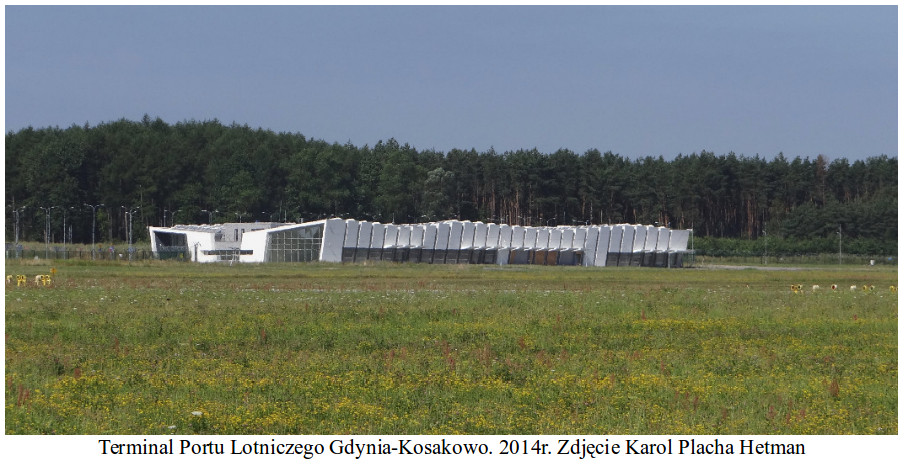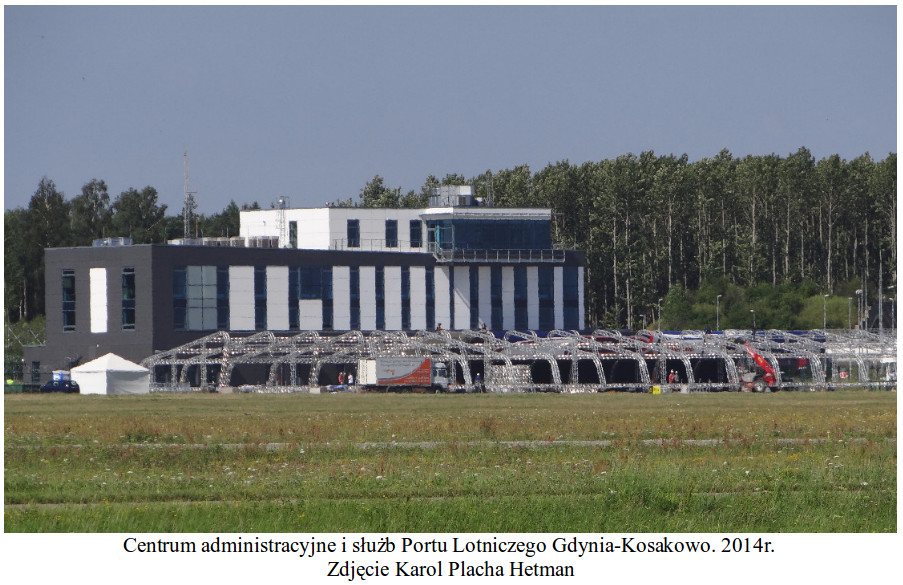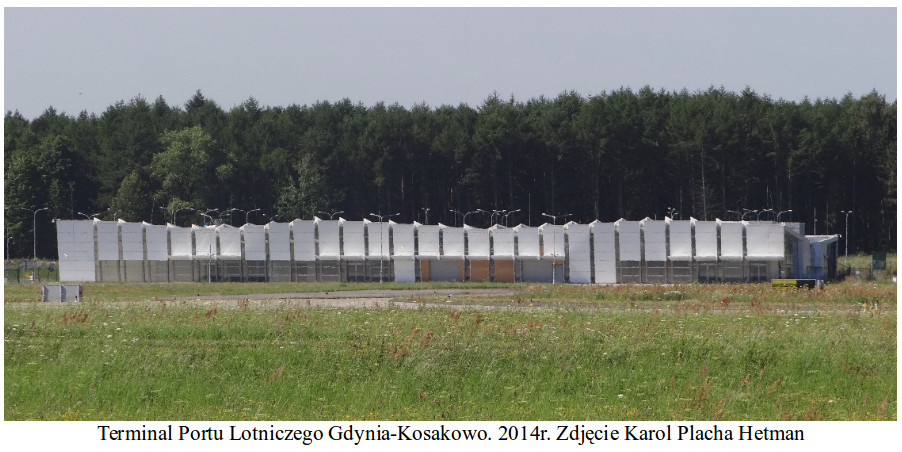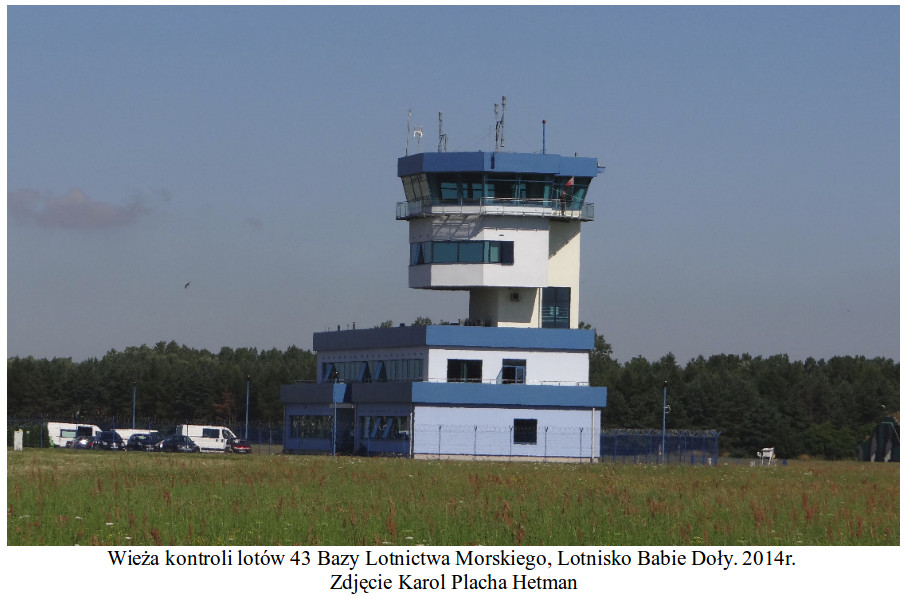Gdynia 2014-11-27
Gdynia Kosakowo Airport.
Subjective article.
The hero of this article is the non-functioning Gdynia-Kosakowo Airport, which physically exists only in the form of a deteriorating Terminal and a pile of papers, declarations, arrangements and EU funds that had to be returned. This is another shame for Poland, under the rule of the Masonic-Liberal coalition of the Civic Platform and the Polish People’s Party. First things first;
For several decades, the Polish Military Airport, extremely important for the defense of the Republic of Poland, has been operating in Gdynia – Babie Doły. Already in 1920, the Polish Maritime Aviation Unit operated in nearby Puck. In recent years, we have witnessed the liquidation of the Polish Army, including the Polish Military Aviation. Post-military airports are more or less legally taken over by various companies. Especially those that are located near large metropolises, because you can earn good money on them. The boys from the Tri-City wanted to earn money at Babie Doły Airport a long time ago. They counted on the liquidation of the Military Airport. Luckily. The Polish Army invested and invests too much in this airport to get rid of it. That is why the boys from the Tri-City used the second variant of action. Transformation of the airport into a civil-military facility, where it was officially intended to launch commercial passenger and cargo traffic. The problem, however, is that the Tri-City has the constantly expanded Rębiechowo Airport, which covers 100% of the needs of the region. Even sports aviation has its base at the nearby Pruszcz Gdański Airport. It was only after some time that information penetrated the public opinion that the boys from the Tri-City wanted to make a private airport of General Aviation class, i.e. an airport for VIPs, not for poor Kowalski.
The machine has already started. The airport was named Gdynia-Kosakowo Airport. This suggests to a citizen of the Republic of Poland that a completely new facility is being built; "an airport that will support the development of the region". For the allegedly new airport, the IATA code – QYD and the ICAO code – EPOK (OK stands for Oksywie) were obtained. As DS (RWY) for the "new airport", the parameters of the RWY Babie Doły Airport (Concrete, 2500 x 60 m, Direction 13/31) were given, and none of the Euro-pencil holders even bothered to verify it. The company attributes to itself the investments made at the Babie Doły Airport; November 2007, launch of the ILS system. 2009, commissioning of a new air traffic control tower, 22.3 m high.
Even the website of Gdynia Kosakowo Airport was launched; http://www.airport.gdynia.pl/. The website is still active (2023).
The first attempts at the Babie Doły Airport for a military-civil function were made in the 90s of the 20th century, when the mayor of Gdynia was the late. Mrs. Franciszka Cegielska (1990-1998). There was an idea to use the airport as cargo. Especially in situations when the weather conditions at the Rębiechowo Airport will be worse than in Babie Doły. At that time, however, the regulations prevented such a solution. 34 PLM and MiG-21 bis fighters were stationed in Babie Doły. Currently (2014) it is widely believed that combat aircraft will not return to Babie Doły. In my opinion – you never know! The Polish Army still maintains SAR duty in Babie Doły and operates liaison flights. And if comrade Vladimir Putin (Moscow Tsar) continues to pursue an aggressive policy, then the combat machines will have to return here.
In 2003, the Tri-City managed to organize the Open’er Festival, a large music event, on the field of flight of Babie Doły Airport. It was the first joint military-civilian venture.
2006 year.
In 2006, an agreement was signed on the use of Babie Doły Airport for civil aviation purposes. They participated in the agreement; Minister of National Defence, Commander of the Navy, Voivode and Marshal of Pomerania, Mayors of Gdynia, Sopot and Gdańsk, Mayor of Kosakowo Commune. The representative of the user, i.e. Naval Aviation, did not participate in the work on the contract. Management of the airport on the civil side was to be exercised by the Management Board of Gdańsk Rębiechowo Airport. The main shareholders were; the municipality of Gdańsk (33.6%) and the Pomeranian Voivodeship (32.8%). Gdynia also had shares in it.
Supporters pointed out; “The construction of the terminal, airport infrastructure, modernization of access to the center of Gdynia, the construction of 700 meters of new road and the addition of railway tracks will require approximately PLN 135 million. This is a surprisingly low amount. The construction of the first stage of the metropolitan railway will cost almost five times as much (PLN 600 million), and Gdańsk spent a little less on the construction of the tram line to Chełm (PLN 80 million). Gdynia should not have any problems with collecting the appropriate amount, especially since private capital was reportedly burning to co-finance the investment. Mr. Jerzy Włudzik, the mayor of the Kosakowo commune, where 98% of the airport area is located, said: “Chinese businessmen who want to build a cargo terminal at the airport with their own money are already contacting me. Mr. Wojciech Szczurek (Mayor of Gdynia) mentioned the interest of American, British and French companies in the investment.
Why does the Tri-City need a second airport when the port in Rębiechowo is being expanded? The Mayor of Gdynia mentioned one argument after another: “The second civil airport is a development for the entire region. We have six times less airports than the EU average in relation to the area of the country, and seven times less in relation to the number of inhabitants. We are still a little mobile nation (last place in the EU in terms of the number of passengers per capita), but that is changing. In Europe, there are agglomerations comparable in size to the Tri-City, where there is more than one airport.” The Mayor of Gdynia was not only a politician determined to open an airport in Kosakowo, but also conciliatory, he devoted almost as much time to praising the idea of building an airport in Kosakowo as convincing that it would not be a competitor to Rębiechowo.
2007 year.
However, what happened between 2006 and March 2007 did not inspire optimism. Apart from the indicated documents, the project manager did little. The enthusiastic comments made to the cameras and microphones of the media are over. In March 2007, the project of adapting the Babie Doły Airport to serve civil air traffic received a positive opinion from the State Airports Enterprise.
In July 2007, the city of Gdynia and the commune of Kosakowo reached an agreement and established the company Gdynia-Kosakowo Airport. The shares in the company were divided: Gdynia 60%, Kosakowo 40%.
Since 2007, construction works have been started at the airport to adapt the infrastructure to the new needs, without consulting the Naval Aviation. Decisions were made in Gdańsk and Warsaw as well as Germany and Brussels. In November 2007, the Company applied to the Ministry of National Defense and the Ministry of Transport with a request (relevant documents were prepared) for permission to operate the Gdynia-Kosakowo Airport.
2008 year.
What prevented you from starting the investment? There is no decision by the Minister of National Defense (the airport belongs to the Polish Army, which will remain there even after the opening of the civil airport) and the Minister of Infrastructure, who must agree that Gdynia-Kosakowo Airport will be the entity managing the airport. The problem is that the ministry had already issued a similar consent in 2006, however, indicating the management of the airport in Rębiechowo as the manager of the civil airport in Kosakowo.
On March 6, 2008, a summary of the report commissioned by Port Lotniczy Gdańsk im. Lech Wałęsa by the consulting company PriceWaterHouseCoopers regarding "Assessment of the legitimacy and concept of taking over the role of the manager at Gdynia Kosakowo airport". That is, work began without a thorough assessment of the legitimacy of the entire project. It was a time when the boys from the Tri-City felt very strong. They felt they could do whatever they wanted because they had the blessing of the Masonic-liberal government of Donald Tusk. Completing the report after the commencement of activities is just a diversion of further social funds. It is also worth mentioning that the entire report has never been made public, only its summary.
2009 year.
On 23.07.2009, representatives of both communes (Gdynia and Kosakowo) signed a notarial deed establishing the company "Gdynia Kosakowo Airport". The first investments were financed from the own resources of the municipalities concerned.On September 3, 2009, a tender was announced for the master plan of the airport. They acted on the basis of fait accompli, still hoping that any day the Polish Army would leave Babie Doły. However, at that time, it was the Ministry of National Defense that financed the construction of a new air traffic control tower, ILS landing system and a new fencing of the entire base from national funds.
On December 18, 2009, a new air traffic control tower was commissioned, which is operated by soldiers of the 43rd Naval Air Base. The Polish Army was happy with the new investment, because the previous air traffic control tower was no longer properly fulfilling its role.
2010 year.
On October 18, 2010, a tender for the construction of the Terminal was announced. In December 2010, the competition for the design of the Terminal in Gdynia-Kosakowo was settled, which was won by the Warsaw-based ATI company.
In 2010, the local government company Pomorska Kolej Metropolitarna was established, one of the goals of which was to connect the airport in Kosakowo with the Tri-City agglomeration.
2011 year.
In 2011, the atmosphere was very dense, due to the upcoming EURO 2012 football tournament. There was a fear that the Rębiechowo Airport would not be able to cope with the increased passenger traffic. The company hoped that this was a good time to take a significant step forward. In 2011, the Company hoped that the airport would open in a provisional form for the EURO 2012 football event. A provisional terminal was to be erected, which was to be made of ready-made elements. However, that did not happen.
In 2011, Mawilux, a subsidiary of Elektrotim, signed a contract with Gdynia-Kosakowo Airport for the execution of aviation lighting; navigation lights and power installation. The value of the contract was PLN 7.3 million. The scope of work included both the design documentation and the construction and commissioning of lighting for the runway and taxiway. The works lasted until July 2012.
In October 2011, the design of the administrative center and services of the Gdynia-Kosakowo Airport was ready. The building was erected and became the seat of all services responsible for security at the Gdynia airport and the port management. The design of the facility was prepared by a consortium of two design offices, ARPRO Pracownia Projektowa Sp. z o. o. and POLEKO Sp. z o. o. A four-storey block with a total volume of almost 10,000 m3. The architectural form is to refer to the terminal, which was built in its close vicinity. It will house, above all, the base of the Airport Fire Brigade as well as office and training facilities as well as sanitary and social facilities for all services and operators operating at the civil airport, i.e. for: Customs Service, Airport Security Service, Police, Airport Management, Handling, Technical Service Maintenance of the Airport, the Operational Duty Service of the Airport, and in the future also the Border Guard. The project was prepared in such a way that, as the airport develops, it can be expanded by another 3,000 m3 of volume.
2012 year.
In early 2012, construction work on the terminal began. The contractor was Sport Halls from Wrocław. At that time, it turned out that the investment being implemented was a VIP terminal; GA (General Aviation), for aircraft of reference code 4B. The facility was to be built within 11 months at a cost of PLN 20.9 million. The GA terminal is a one-story facility with a usable area of 3,900 m2 and a volume of 21,300 m3.
There were plans to build an apron and a fuel depot. Both objects implemented in the mode; design and build, which shortens the implementation time by bureaucratic work.
However, in June 2012, the Board; Gdynia-Kosakowo Airport has decided to withdraw from the contract concluded with Sport Halls for the construction of the General Aviation passenger terminal. The reason for breaking the contract was the inability to complete the investment on time and the lack of agreement between the parties to the contract. The contract with Sport Hall was signed at the beginning of 2012 and covered the construction of a new terminal with connection to city and airport networks. The value of the contract was almost PLN 21 million. However, after some time, Sport Hall returned and completed the investment. In June 2012, construction was 95% complete. At the end of July 2013, Sport Halls returned to the construction site. In autumn 2013, Gdynia Kosakowo Airport was completed but not launched and officially opened.
The lush plans of the boys from the Tri-City indicated that the airport in the first years was to receive small business planes, cargo and charter flights. It was hoped that in 2030, the airport would serve 1.5 million passengers, and a little earlier, in 2022, the airport would be in the black.
2013 year.
Unfortunately, that won’t happen. In 2012, the main investments of boys from the Tri-City failed. The Amber Gold parabank and the German-Gdańsk OLT airline fell apart. At the moment (2014), the rulers of the Republic of Poland, freemasons and liberals have extinguished the fire, but the heat is still there. Germania, which has so far been favorable to the activities of the boys from the Tri-City, made a turn and on July 2, 2013, the European Commission announced that it had initiated an investigation into the financing of the construction of a civil airport in Gdynia. In particular, the European Commission had doubts about the estimates in the business plan regarding the volume of air traffic and revenues in a situation where the nearby Gdańsk-Rębiechowo Airport is not overloaded (2012, – 2.9 million people with a capacity of 5 million passengers) and offers lower airport charges than those provided for the Gdynia-Kosakowo port. The authorities of Gdynia, in the notification to the European Commission examining the correctness of maintaining the market balance at the time of granting the company Port Lotniczy Gdynia Kosakowo a subsidy of EUR 52 million (~ PLN 217 million, at the exchange rate of EUR as at 12.07.2013), provided untrue data on the level of passenger traffic and capacity of the Rębiechowo Airport. With this in mind, on June 28, 2013, the Mayor of Gdynia proposed to conclude an agreement under which Gdańsk Airport sp. z o.o. would act as the entity managing the Gdynia airport and operating on the infrastructure of the Gdynia-Kosakowo airport. The Polish authorities maintain that the recapitalization was granted on market terms. It didn’t do much. The European Commission ordered the funds returned.
And by the way, the other side of the coin. The amount was supposed to be over PLN 100 million. EU subsidies alone exceeded PLN 200 million. So how much did this investment actually cost?
In such conditions, the smarter ones always speak out, including Janusz Lewandowski, the one who effectively liquidated Polish factories by selling them for next to nothing. His "successes" in the Republic of Poland were noticed in Western Europe and he is currently (2013) the Commissioner of the European Union. This is the same function as a Commissioner in a council country. On November 10, 2013, Mr. Janusz Lewandowski made his statement; “Using funds from the EU budget for 2014-2020, Poland cannot afford projects that have no economic justification. We are overly ambitious when it comes to building airports.” In his opinion, Poland cannot afford projects that "follow the wishes of various local centres, but have no economic justification. We will immediately be perceived as an example of a country that has received the most, but at the same time deals irrationally with a large national envelope. An example of this today is our excessive ambitions in terms of airports. We seem to have a bit too many airport initiatives for a country with so much passenger and cargo traffic,” added the Commissioner. Genius! But what did Mr. Janusz Lewandowski do before? Didn’t he notice that there is so little air traffic in Poland because there are few public airports? That Poles earn too little to fly as often as he does.
It is worth mentioning that Gdynia Kosakowo Airport is not the only unfinished idea of the Government in the Republic of Poland. Certainly, the missed programs include the Szymany Airport, from which the Great Lakes are still 100 km away. EU subsidies were also sought for this project. Let me remind you that in the 90s of the 20th century, LOT Polish Airlines launched connections from this airport and it ended in a fiasco. This does not mean that the Republic of Poland does not need new airports. A perfect example is Lublin and Modlin, and in my opinion also Radom, Słupsk and Zegrze Pomorskie.
The whole of 2013 was a period of strenuous search for those responsible for the fiasco in Gdynia. Instead of orders, carnations, teddy bears and lavish bonuses, the witch hunt began. Not in the regime media, but in the independent media, something came to light. The boys from the Tri-City put on a good face and claimed that the port would open soon. Blaming all the blame on the President of Gdynia, Wojciech Szczurek, is unfair. Arrangements, consents and decisions were needed and someone issued them. And not only in the Tri-City and Warsaw, but also in Germany and Brussels. Very often, the amount of PLN 100 million was wasted. The presidents of Gdańsk, Sopot and Gdynia clashed in the salons. Mr. Tomasz Kloskowski, the current president of Rębiechów (previously vice-president), believes that the main players, i.e. the mayors of Gdańsk and Gdynia, interpreted earlier agreements differently: Mr. Wojciech Szczurek that the planes would soon take off from Kosakowo, and Mr. Paweł Adamowicz that only when Gdańsk will be 70-80% full, it will be time for a new airport. In Gdynia, they decided that it was time to wait for "the saint of never". Because Gdansk Airport Lech Wałęsa, especially for Euro 2012, started intensive expansion, the largest in its history so far – for PLN 400 million, almost half of which came from the EU. In this situation, the residents of Gdynia started working on the airport on their own, together with the Kosakowo commune.
Gdynia-Kosakowo Airport.
Gdynia-Kosakowo Airport today (2014) Polish Army Airport Babie Doły or historically Oksywie. 2014.
Basic information: 7 km from the center of Gdynia, 3 km from the sea port. 800 ha of land (Rębiechowo has an area of 200 ha). New terminal. Airport Administration and Services Centre. New air traffic control tower. Shelter-hangars can be used as warehouses. First RWY 2 400 m x 60 m. Second RWY (RWY). Full navigation lighting system including PAPI lights. ILS system.
2020 year.
Finally, the company Port Lotniczy Gdynia-Kosakowo Spółka z o.o. declared bankruptcy. The company’s assets were put up for sale under the bankruptcy law.Written by Karol Placha Hetman




